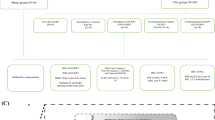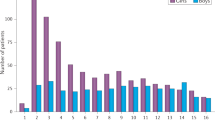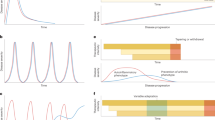Abstract
Systemic-onset juvenile idiopathic arthritis (s-JIA) is a rare inflammatory disease classified as a subtype of chronic childhood arthritis, manifested by spiking fever, erythematous skin rash, pericarditis and hepatosplenomegaly. The genetic background underlying s-JIA remains poorly understood. To detect disease-related copy number variations (CNVs), we performed single-nucleotide polymorphism array analysis in 50 patients with s-JIA. We detected many CNVs, but most of them were inherited from either of normal-phenotype parents. However, in one patient, we could identify two de novo microduplications at 19q13.42 with the size of 77 and 622 kb, separated by a 109-kb segment of normal copy number. The duplications encompass NLRP family (NLRP2, NLRP9 and NLRP11) as well as IL11 and HSPBP1, all of which have an important role in inflammatory pathways. These genes may significantly contribute to the pathogenesis of s-JIA.
Similar content being viewed by others
Log in or create a free account to read this content
Gain free access to this article, as well as selected content from this journal and more on nature.com
or
References
Symmons, D. P., Jones, M., Osborne, J., Sills, J., Southwood, T. R. & Woo, P. Pediatric rheumatology in the United Kingdom: data from the British Pediatric Rheumatology Group National Diagnostic Register. J. Rheumatol. 23, 1975–1980 (1996).
Hinks, A., Barton, A., Shephard, N., Eyre, S., Bowes, J., Cargill, M. et al. Identification of a novel susceptibility locus for juvenile idiopathic arthritis by genome-wide association analysis. Arthritis Rheum. 60, 258–263 (2009).
Glass, D. N. & Giannini, E. H. Juvenile rheumatoid arthritis as a complex genetic trait. Arthritis Rheum. 42, 2261–2268 (1999).
Thomson, W. & Donn, R. Juvenile idiopathic arthritis genetics—What's new? What's next? Arthritis Res. 4, 302–306 (2002).
Fishman, D., Faulds, G., Jeffery, R., Mohamed-Ali, V., Yudkin, J. S., Humphries, S. et al. The effect of novel polymorphisms in the interleukin-6 (IL-6) gene on IL-6 transcription and plasma IL-6 levels, and an association with systemic-onset juvenile chronic arthritis. J. Clin. Invest. 102, 1369–1376 (1998).
Donn, R. P., Shelley, E., Ollier, W. E. & Thomson, W. A novel 5′-flanking region polymorphism of macrophage migration inhibitory factor is associated with systemic-onset juvenile idiopathic arthritis. Arthritis Rheum. 44, 1782–1785 (2001).
Donn, R., Alourfi, Z., De Benedetti, F., Meazza, C., Zeggini, E., Lunt, M. et al. Mutation screening of the macrophage migration inhibitory factor gene: positive association of a functional polymorphism of macrophage migration inhibitory factor with juvenile idiopathic arthritis. Arthritis Rheum. 46, 2402–2409 (2002).
De Benedetti, F., Meazza, C., Vivarelli, M., Rossi, F., Pistorio, A., Lamb, R. et al. Functional and prognostic relevance of the −173 polymorphism of the macrophage migration inhibitory factor gene in systemic-onset juvenile idiopathic arthritis. Arthritis Rheum. 48, 1398–1407 (2003).
Nannya, Y., Sanada, M., Nakazaki, K., Hosoya, N., Wang, L., Hangaishi, A. et al. A robust algorithm for copy number detection using high-density oligonucleotide single nucleotide polymorphism genotyping arrays. Cancer Res. 65, 6071–6079 (2005).
Tschopp, J., Martinon, F. & Burns, K. NALPs: a novel protein family involved in inflammation. Nat. Rev. Mol. Cell. Biol. 4, 95–104 (2003).
Drenth, J. P. & van der Meer, J. W. The inflammasome—a linebacker of innate defense. N. Engl. J. Med. 355, 730–732 (2006).
Jeru, I., Duquesnoy, P., Fernandes-Alnemri, T., Cochet, E., Yu, J. W.,, Lackmy-Port-Lis, M. et al. Mutations in NALP12 cause hereditary periodic fever syndromes. Proc. Natl Acad. Sci. USA 105, 1614–1619 (2008).
Hoffman, H. M., Mueller, J. L., Broide, D. H., Wanderer, A. A. & Kolodner, R. D. Mutation of a new gene encoding a putative pyrin-like protein causes familial cold autoinflammatory syndrome and Muckle–Wells syndrome. Nat. Genet. 29, 301–305 (2001).
Bruey, J. M., Bruey-Sedano, N., Newman, R., Chandler, S., Stehlik, C. & Reed, J. C. PAN1/NALP2/PYPAF2, an inducible inflammatory mediator that regulates NF-kappaB and caspase-1 activation in macrophages. J. Biol. Chem. 279, 51897–51907 (2004).
Sims, N. A. & Walsh, N. C. GP130 cytokines and bone remodelling in health and disease. BMB Rep. 43, 513–523.
Girasole, G., Passeri, G., Jilka, R. L. & Manolagas, S. C. Interleukin-11: a new cytokine critical for osteoclast development. J. Clin. Invest. 93, 1516–1524 (1994).
Heymann, D. & Rousselle, A. V. gp130 cytokine family and bone cells. Cytokine 12, 1455–1468 (2000).
Kudo, O., Sabokbar, A., Pocock, A., Itonaga, I., Fujikawa, Y. & Athanasou, N. A. Interleukin-6 and interleukin-11 support human osteoclast formation by a RANKL-independent mechanism. Bone 32, 1–7 (2003).
Hill, P. A., Tumber, A., Papaioannou, S. & Meikle, M. C. The cellular actions of interleukin-11 on bone resorption in vitro. Endocrinology 139, 1564–1572 (1998).
Mima, T., Ishikawa, S., Aoki, C., Yoshio-Hoshino, N., Adachi, Y., Imagawa, T. et al. Interleukin 11 and paired immunoglobulin-like type 2 receptor alpha expression correlates with the number of joints with active arthritis in systemic juvenile idiopathic arthritis. Ann. Rheum. Dis. 68, 286–287 (2009).
Gething, M. J. & Sambrook, J. Protein folding in the cell. Nature 355, 33–45 (1992).
Welch, W. J., Kang, H. S., Beckmann, R. P. & Mizzen, L. A. Response of mammalian cells to metabolic stress; changes in cell physiology and structure/function of stress proteins. Curr. Top. Microbiol. Immunol. 167, 31–55 (1991).
Albani, S. & Carson, D. A. A multistep molecular mimicry hypothesis for the pathogenesis of rheumatoid arthritis. Immunol. Today 17, 466–470 (1996).
van Eden, W., van der Zee, R., Paul, A. G., Prakken, B. J., Wendling, U., Anderton, S. M. et al. Do heat shock proteins control the balance of T-cell regulation in inflammatory diseases? Immunol. Today 19, 303–307 (1998).
Shomura, Y., Dragovic, Z., Chang, H. C., Tzvetkov, N., Young, J. C., Brodsky, J. L. et al. Regulation of Hsp70 function by HspBP1: structural analysis reveals an alternate mechanism for Hsp70 nucleotide exchange. Mol. Cell 17, 367–379 (2005).
Raynes, D. A. & Guerriero, V. Jr Inhibition of Hsp70 ATPase activity and protein renaturation by a novel Hsp70-binding protein. J. Biol. Chem. 273, 32883–32888 (1998).
Bovolenta, M., Neri, M., Fini, S., Fabris, M., Trabanelli, C., Venturoli, A. et al. A novel custom high density-comparative genomic hybridization array detects common rearrangements as well as deep intronic mutations in dystrophinopathies. BMC Genom. 9, 572 (2008).
Gimelli, S., Caridi, G., Beri, S., McCracken, K., Bocciardi, R., Zordan, P. et al. Mutations in SOX17 are associated with congenital anomalies of the kidney and the urinary tract. Hum. Mutat. 31, 1352–1359.
Acknowledgements
We thank patients and their families for their participation in this study. This work was supported by grants from the Ministry of Education, Culture, Sports, Science and Technology (NM), the Japan Science and Technology Agency (NM), the Ministry of Health, Labour and Welfare, Japan (SY and NM) and Mother and Child Health Foundation (NM).
Author information
Authors and Affiliations
Corresponding author
Rights and permissions
About this article
Cite this article
Tadaki, H., Saitsu, H., Nishimura-Tadaki, A. et al. De novo 19q13.42 duplications involving NLRP gene cluster in a patient with systemic-onset juvenile idiopathic arthritis. J Hum Genet 56, 343–347 (2011). https://doi.org/10.1038/jhg.2011.16
Received:
Revised:
Accepted:
Published:
Issue date:
DOI: https://doi.org/10.1038/jhg.2011.16
Keywords
This article is cited by
-
Chromosomal abnormalities related to fever of unknown origin in a Chinese pediatric cohort and literature review
Orphanet Journal of Rare Diseases (2022)
-
Prenatal detection and molecular cytogenetic characterization of 19q13.42 microduplication: three reported cases and literature review
Molecular Cytogenetics (2021)



